Barred Plymouth Rock: Breed Profile
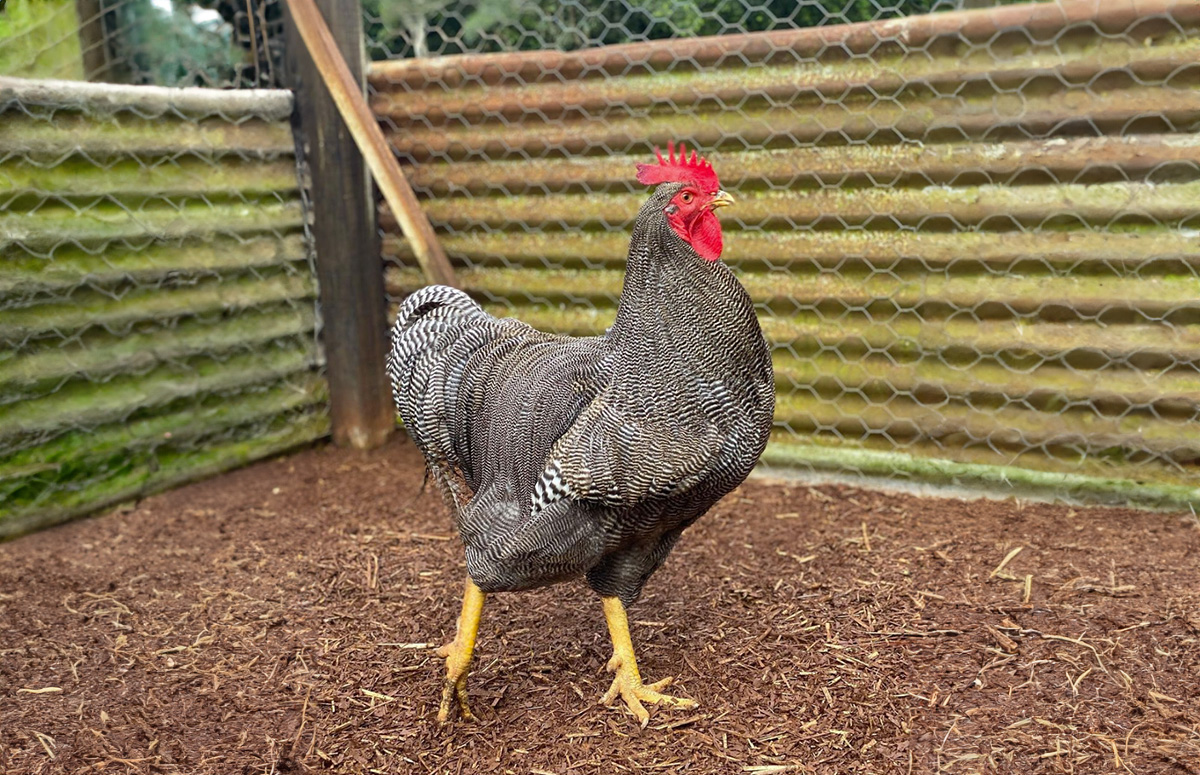
Characteristics | Eggs | Chicks | Rooster vs Hen | Pros & Cons | Barred Plymouth Rock vs Dominique | Barred Plymouth Rock vs Malines | Climate | Barred Pattern | History | Personality
Plymouth Rock chickens are among the most popular chicken breeds in the United States. While there are many varieties, the most common is the Barred Plymouth Rock, also known as the Barred Rock. This breed’s distinctive black-and-white striped feathers make it a favorite among poultry keepers and farmers. Let’s explore the characteristics of the Barred Rock, shedding light on why they are so popular.
- Plymouth Rock hens lay 200 eggs per year
- Easy to care for and beginner-friendly
- Cold- hardy chicken breed
- Friendly but assertive
- Larger breed
- 200 Large Brown Eggs Yearly
- Kept for Both Meat and Eggs
- Cold-Hardy Birds
- Assertive Towards Other Breeds
- Not Fond of Hot Temperatures
- Foragers; Need Space
Characteristics
The Barred Plymouth Rock’s most captivating feature is its black and white striped feathering. This barred pattern is seen across the body, including neck and tail feathers. This pattern is caused by a gene, called the barring gene. The Barred Rock has slowly growing feathers, which creates a very sharp lining compared to other breeds that carry the gene.
| Eggs | Up to 200 eggs per year |
| Egg Color | Brown |
| Egg Size | Large |
| Weight | 7.5 – 9.5 lbs |
| Hardiness | Cold |
| Temperament | Docile, but assertive |
| Beginner-friendly | Yes |
| Color | Black and white barring pattern |
Barred Rocks are medium to large-sized chickens with a broad and rectangular body. Their well-proportioned build makes them suited for both eggs and meat. Hens weigh around 7.5 lbs (3.4kg), while roosters tip the scale at 9.5 lbs (4.3kg).
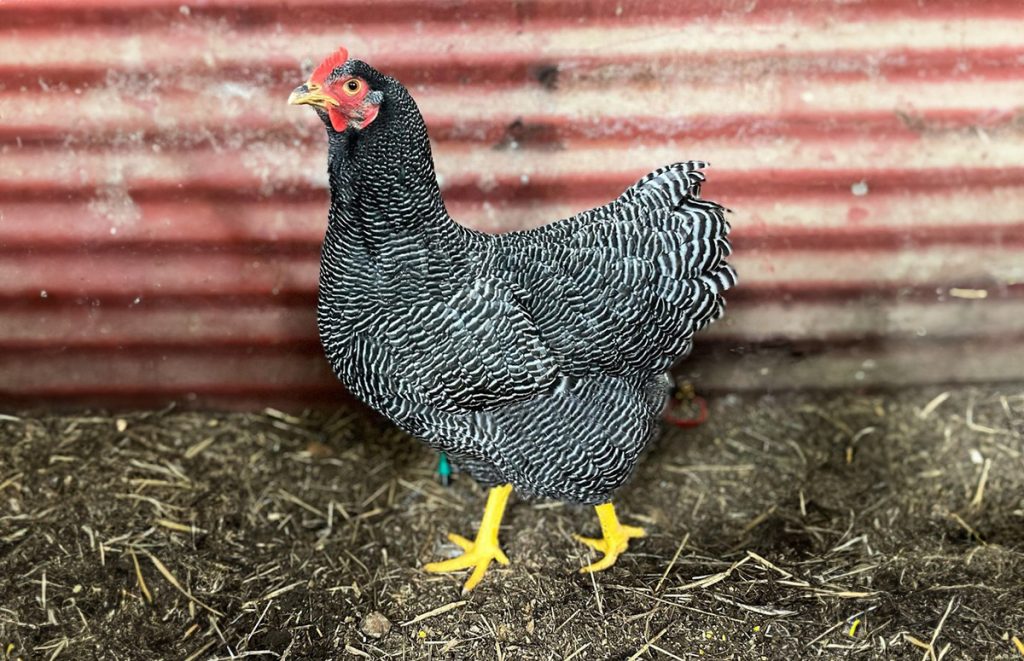
The legs of Barred Plymouth Rocks are yellow, with four toes on each foot. Their beak is yellow as well and the eyes reddish-bay.
Eggs
Barred Plymouth Rocks are a dual-purpose breed, but most chicken owners keep them for the eggs. They are reliable layers, bringing around 200 eggs per year to the table; that’s four eggs weekly. This means you can expect to collect eggs regularly during the laying months.
They lay brown eggs. The shade of brown may vary from light to medium brown, depending from bird to bird.
While Barred Rocks can go broody, they are not as inclined to broodiness as other breeds. This is beneficial for those only interested in egg production, as hens temporarily stop laying during broodiness.
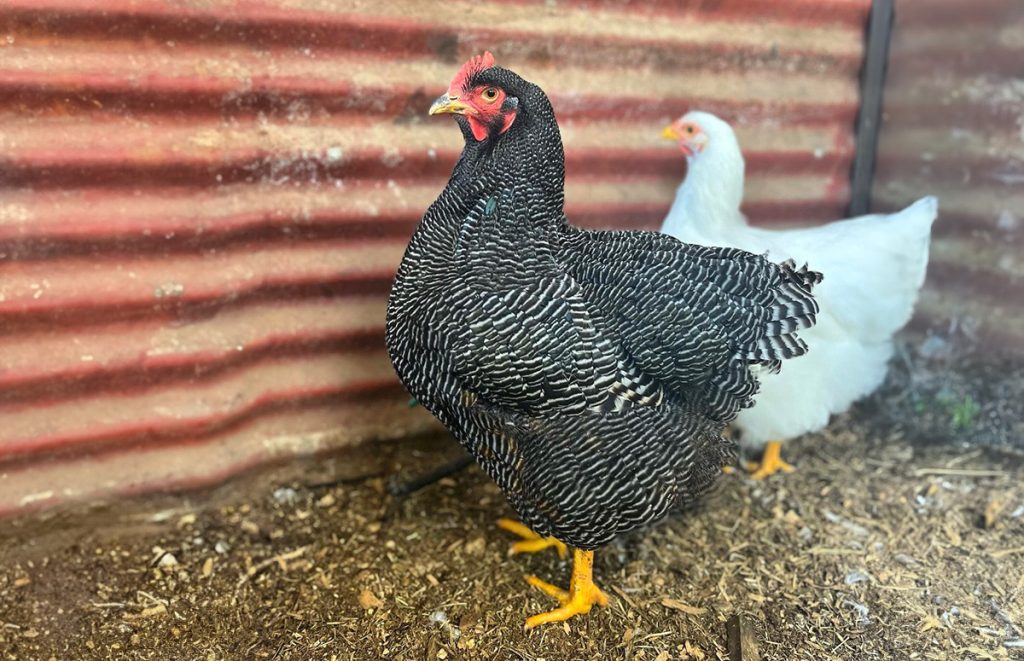
Barred Plymouth Rock Chicks
One of the most fascinating aspects of the Barred Rock chicken is its ‘barring gene‘, causing not only the striped pattern but also making it possible to separate male and female Barred Rocks right after hatching. The barring gene is what they call a ‘sex-linked‘ gene.
Compared to hens, Barred Plymouth Rock rooster chicks tend to be lighter in color. This results from carrying two copies of the sex-linked barring gene, which causes the white bars to be broader and more prominent.
Next to that, a distinguishing feature of freshly hatched Barred Rock roosters is a small white dot on the top of their heads.
Hens only carry one copy of the sex-linked barring gene, resulting in more narrow white barring and a darker color. They also don’t have the white spot on their heads.
So, in a nutshell, the sex-linked barring gene not only gives them a fantastic striped pattern but also gives an early clue about their gender.
Barred Plymouth Rock Rooster vs Hen
As mentioned before, thanks to the barring gene, males and females can be separated from each other right after hatching by looking at the color of their dawn. Male Barred Rocks tend to be lighter and have a white dot on their head, while females are darker.
So, unlike most other heritage chicken breeds, you don’t have to wait a few months to determine their gender. But even as adults, there remain noticeable differences and similarities between males and females.
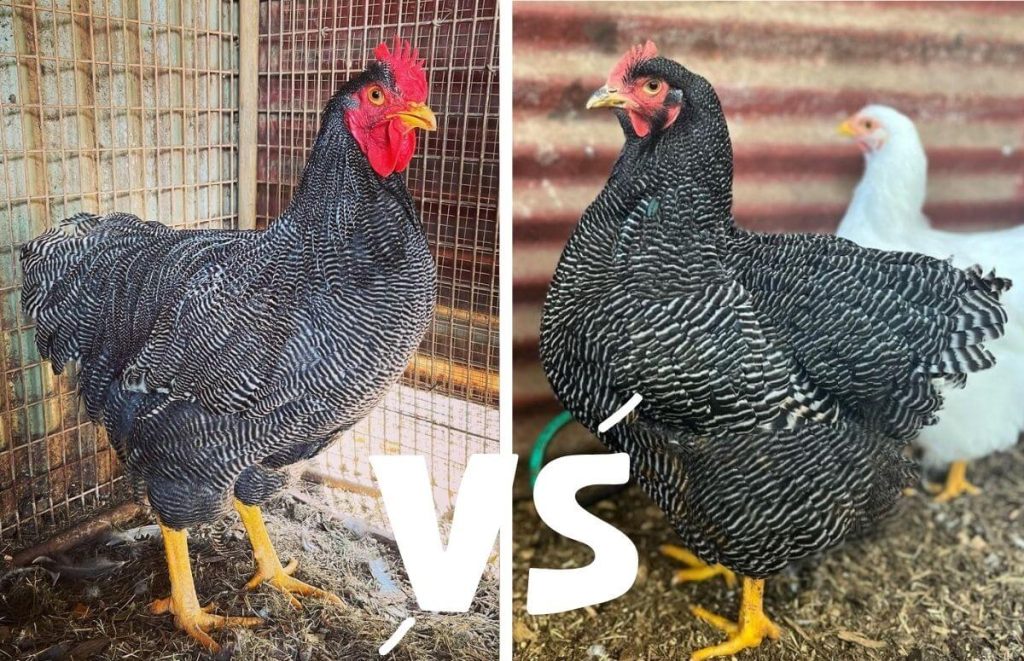
Both male and female Barred Rocks show the iconic black and white striped feather pattern. They also feature common characteristics like a large body, upright stand, and black downy plumage.
Roosters are generally larger and more robust than hens. They also have larger, more prominent combs and wattles- the combs in particular are often very pronounced.
The pointed saddle feathers and sickles are a unique feature for roosters, as hens have rounded feathers.
| Feature | Barred Rock Rooster | Barred Rock Hen |
|---|---|---|
| Weight | 9.5 lbs | 7.5 lbs |
| Back | Pointed saddle feathers | Rounded feathers |
| Plumage | Black and white striped | Black and white striped |
| Tail Feathers | Long sickles, pointed | Shorter feathers, rounded on the edges |
| Comb, Wattles | Big, red | Smaller, pink |
| Body | Large and broad with long legs | Smaller, shorter legs |
Pros and Cons of the Barred Plymouth Rock
The Barred Plymouth Rock is one of the most popular chicken breeds in the US, but it has its own pros and cons. Let’s address the most important advantages and disadvantages.
Barred Plymouth Rocks are known for their reliable egg production. Although not the best layers compared to real egg machines, they lay a consistent and good amount of around 4 eggs weekly.
They are considered dual-purpose, meaning suitable for meat and egg production. This makes them a practical choice for small-scale farming or those who want to live a self-sufficient life.
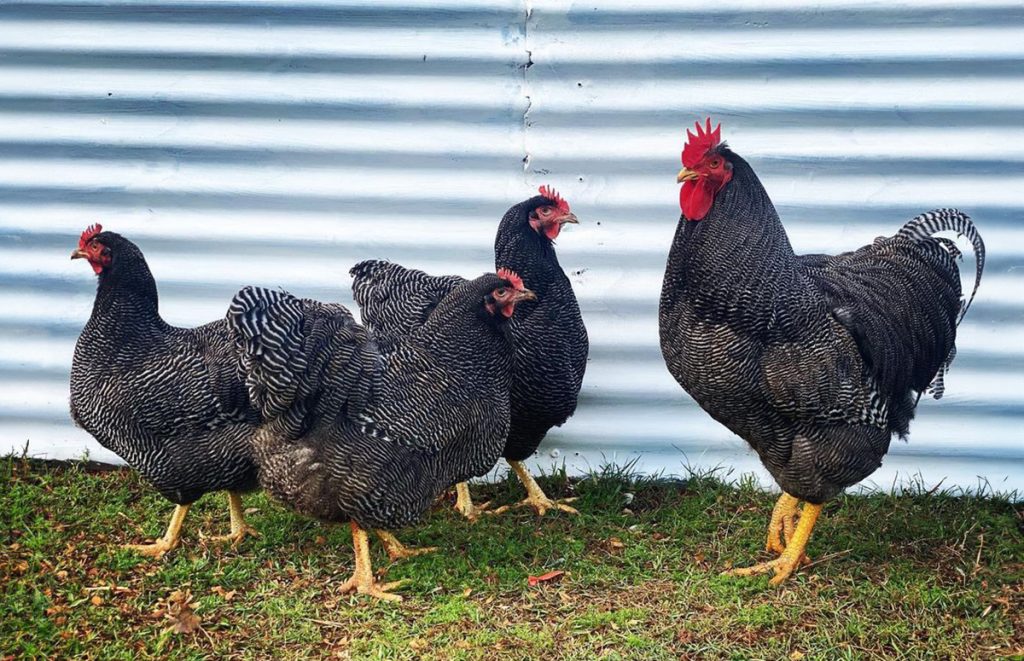
Barred Plymouth Rocks are known for their calm and friendly temperament. They are easy to handle and make good pets or family chickens. They are also very cold-hardy birds that can tolerate a wide range of weather conditions.
On the other hand, Barred Plymouth Rocks require plenty of space to roam and scratch. Crowded conditions will lead to stress and behavioral problems.
Although they are a friendly breed, they tend to be more assertive towards other chickens and are mostly high in the pecking order. Don’t place them with submissive breeds.
Pros
- Cold-hardy
- Excellent foragers
- Dual purpose breed
- Beautiful striped pattern
- Don’t need much extra care
Cons
- Need more space
- Dominant breed
- Don’t do well in warm climates
Barred Rock vs Barred Plymouth Rock
There is no difference between a Barred Rock and a Barred Plymouth Rock. Both are Plymouth Rock chickens and have the barred feather pattern. A Barred Rock’s full name is Barred Plymouth Rock, an official variety of the Plymouth Rock with a barred feather pattern.
Other varieties without this barring also exist, such as the White, Black, Buff, Columbian, and Partridge Plymouth Rock.
Dominique Chicken vs Barred Plymouth Rock
At first sight, Dominique chickens and Barred Rocks seem like identical twins. It’s easy to get a little mixed up when you’re trying to tell them apart. They both showcase a striking striped feather pattern, but there are subtle yet significant differences between these two American breeds.
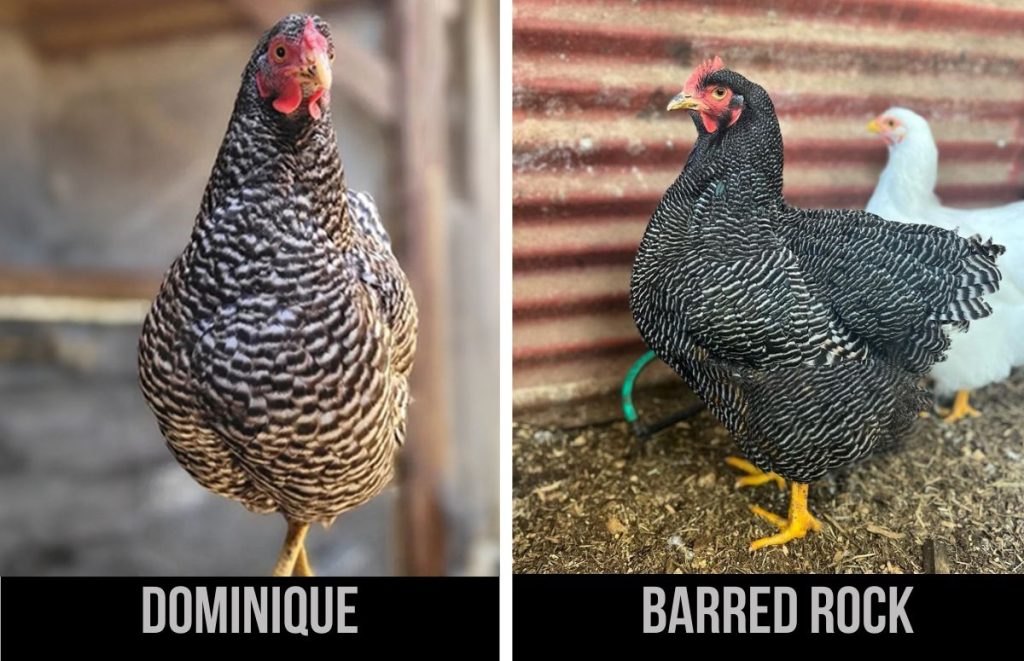
Pattern: While both breeds have striped plumage, the pattern itself is different. Barred Plymouth Rocks have wide, evenly spaced black and white stripes. Dominique chickens, conversely, have a more irregular, “tiger stripe” pattern with thinner, often less-defined bars.
Comb: Plymouth Rocks have a single comb, while Dominique chickens have a flatter, less pronounced rose comb.
Size: Barred Plymouth Rocks are larger than Dominiques. While size alone may not always be a reliable indicator, if you have both breeds side by side, you will notice the difference.
Cuckoo Malines Chicken vs Barred Plymouth Rock
Another example of two chicken breeds getting mixed up is the Cuckoo de Malines and Barred Plymouth Rock. Noticing the differences between these two can be quite a puzzle to the untrained eye.
Color Pattern: Cuckoo de Malines have a ‘cuckoo’ pattern, an irregular mix of dark and light barring on their feathers. While Barred Rocks exhibit a regular and well-defined striped pattern.
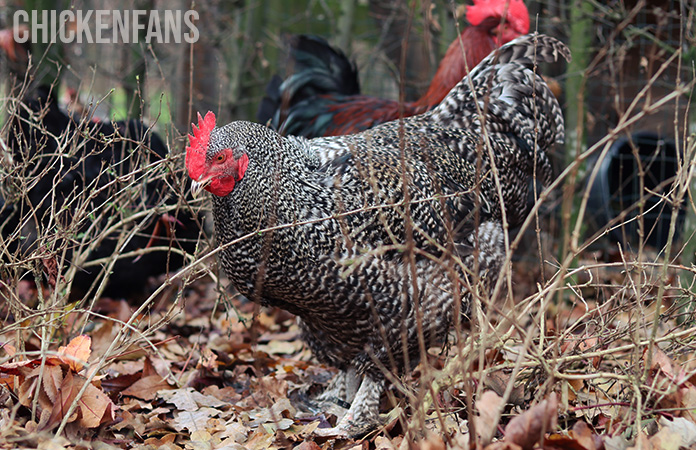
Legs: The legs of the Barred Rock are yellow, while the Malines chicken’s legs are slate blue or grey. Their legs are also feathered, while the Plymouth Rock’s legs are clean.
Size: Cuckoo de Malines are giant chickens. They are generally larger than the Barred Plymouth Rock.
Climate
Barred Plymouth Rocks are known for their adaptability to various climates and can thrive in various weather conditions. However, they tend to do exceptionally well in temperate climates.
They have a hardy nature and can withstand cold weather quite effectively. Their feathering provides insulation, making the breed less prone to cold-related stress or health issues.
They don’t really like hot summers, so they need plenty of shelter and spaces with shade. They aren’t a Mediterranean breed, after all.
The Barred Color Variety
The Barred Plymouth Rock, or Barred Rock, is the most well-known and popular color variety in Plymouth Rock chickens. It comes with white and black barred plumage. The stripes act as camouflage in shady areas. This special pattern is also known as sex-linked barring.
Sex-Linked Barring
The sex-linked barring gene (B) creates dark and light stripes in the feathers. When the feather grows, the barring factor periodically inhibits black pigment deposits, resulting in the barring pattern.
Breeds, like the Barred Plymouth Rock, Delaware, Old English Crele Games, and Coucou de Renne, have this sex-linked barring pattern. Other breeds, like the Campine, have another genetic barring system, called autosomal barring.
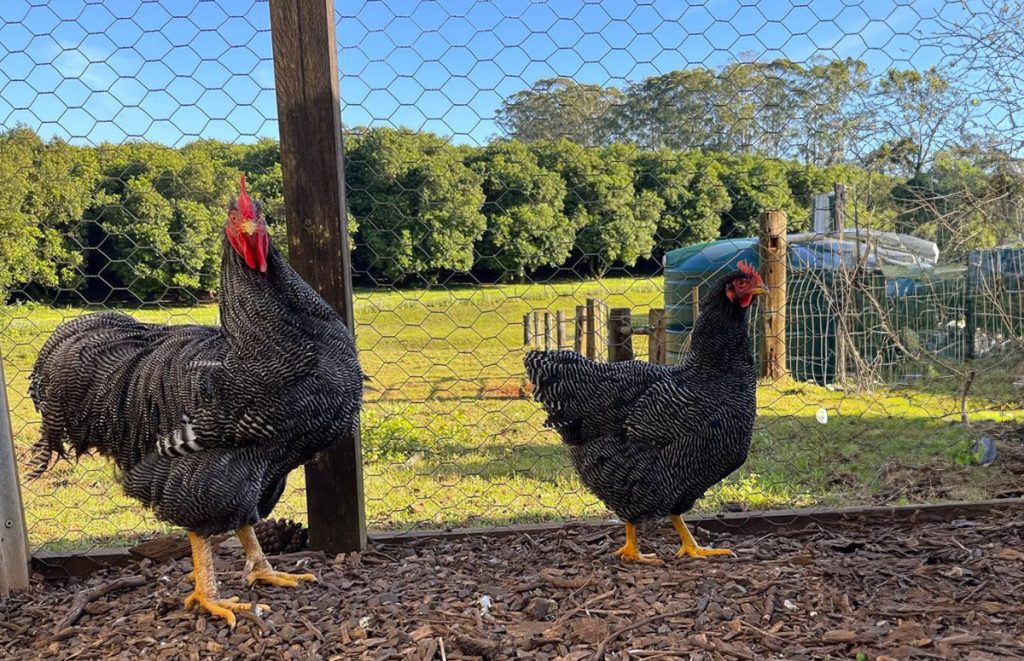
In sex-linked barred breeds like the Barred Plymouth Rock, males have wider white stripes than females. Other characteristics to look for in sex-linked barred chickens are skin with lighter pigment and a small white dot on their heads when they’re newly hatched.
The sex-linked barring gene (B) is dominant and is located on the Z chromosome. Male chickens have two copies of this gene (ZZ), while females have only one (ZW).
History of the Barred Plymouth Rock
The Plymouth Rock chicken has its origins in the United States during the 19th century. Early breeding efforts were concentrated in Massachusetts where the breed’s creators aimed to develop a dual-purpose chicken suitable for both egg production and meat.
The Barred Plymouth Rock, praised for its black-and-white barred plumage, was the original variety officially acknowledged by the American Poultry Association (APA) in 1874. Other colors followed later.
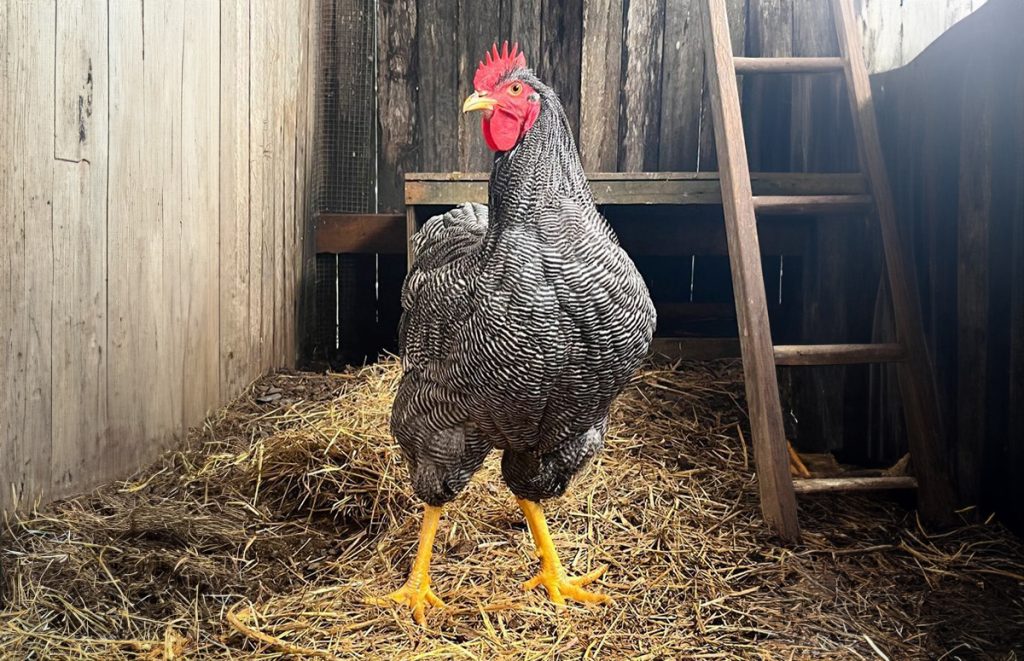
It’s unclear how the first Barred Plymouth Rock was created. Some history books refer to crosses of Brahma and Cochin. Many sources refer to cross-breeding with Dominiques.
Alongside the Barred variety, other Plymouth Rock varieties, such as White Plymouth Rocks and Buff Plymouth Rocks, were developed, each sharing similar features but with different color patterns. The Plymouth Rock was the dominant chicken breed in the US until the rise of broiler farms and the introduction of industrial battery cages at the beginning of the 20th century.
Personality
Plymouth Rock chickens are calm, easy to handle, and docile. They are friendly towards other flock members and humans. They follow you around in the run when you carry some food or do chores.
Barred Rock roosters are almost always good-natured dictators. With a little bit of work, the roosters can be handled, worked around, and controlled with a minimum of fuss. They are generally much less aggressive roosters compared to, say, Leghorns. They keep the peace in the flock without being bullies.
Plymouth Rock hens are most likely to be high in the pecking order as they are a dominant breed.
Related Questions
Yes, both are Plymouth Rock chickens. A Barred Rock’s full name is Barred Plymouth Rock, an official variety of the Plymouth Rock with a barred feather pattern. Other varieties without this barring also exist, such as the White, Black, Buff, Columbian, and Partridge Plymouth Rock.
They lay brown eggs. The shade of brown may vary from light to medium brown, depending from bird to bird.
Other Reads
Here are some of the articles we mentioned:
- Wyandotte Chickens: an overview of the Wyandotte chicken breed and the color varieties
- Plymouth Rock: an overview of the Plymouth Rock breed and other color varieties
- Chicken Feather Guide: to understand the difference between all types of feathers
- Chicken Breeding & Genetics: an overview for chicken breeding and genetics for beginners
If you are considering to get Silver Laced Wyandottes, here are some other resources:
- Chicken Coop Size Calculator: to calculate the size of your coop
- Chicken Raising Guide: general chicken raising guide
Credits for the photos go to Cactus Hill Poultry breeders, specializing in breeding Plymouth Rocks.






















